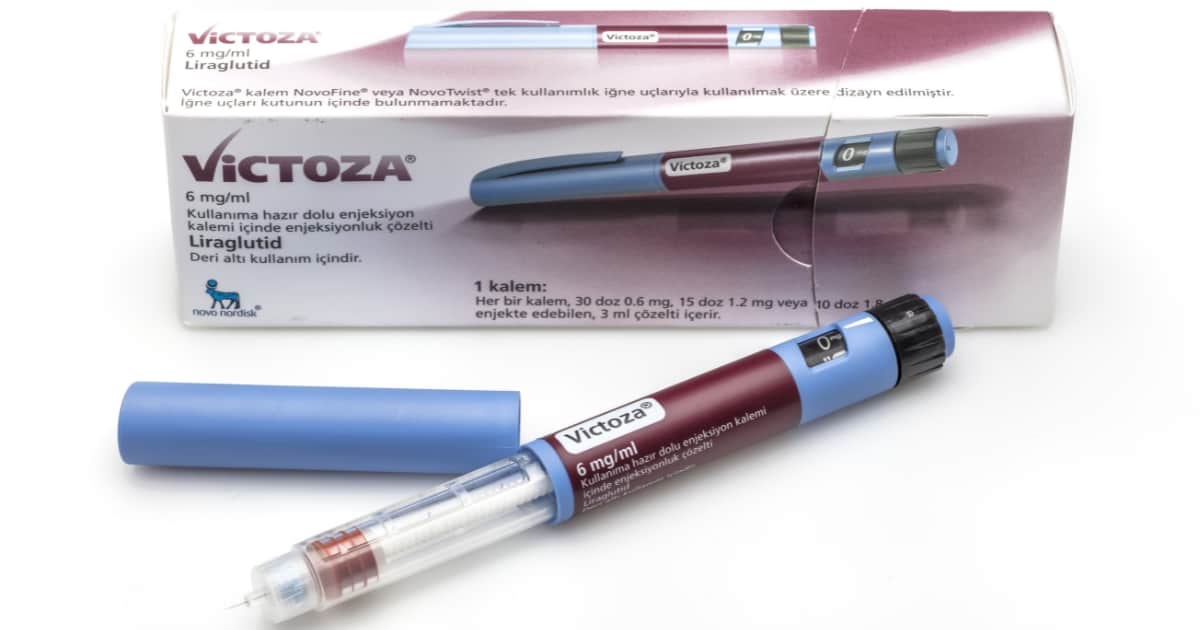Victoza is a popular prescription medication used to manage blood sugar levels for people with type 2 diabetes.
Using it regularly may improve blood sugar and A1C levels, aid in weight loss, and protect against heart attack, stroke, and premature death in people with type 2 diabetes and pre-existing heart disease.
This article will explain everything you need to know about Victoza.

Table of Contents
- What is Victoza?
- How does Victoza work?
- What are the benefits of taking Victoza?
- Why would you be prescribed Victoza?
- What are the side effects?
- What are the typical Victoza doses?
- What is the maximum daily dose of Victoza?
- What happens if you take too much Victoza?
- Can I miss a dose of Victoza?
- How do I inject Victoza?
- Who shouldn’t take Victoza?
- How do I stop taking Victoza?
- Can Victoza replace insulin?
- Can I take Victoza with other diabetes medications?
- Does Victoza need to be refrigerated?
- How do I get a prescription for Victoza?
What is Victoza?
Victoza is a name-brand injectable drug created by Novo Nordisk. The Food and Drug Administration (FDA) approved it for use in the United States in 2010.
It falls under the glucagon-like peptide-1 (GLP-1) receptor agonist drug class. Its main ingredient is liraglutide.
It is similar to medications such as Trulicity, Ozempic, and Mounjaro.
It is injected subcutaneously (taken under the skin) once daily and can be taken with insulin or other diabetes medications.
How does Victoza work?
Victoza helps to lower blood sugar in a few different ways.
It naturally stimulates insulin production from the pancreas. This helps prevent blood sugar spikes after meals, slows digestion, and suppresses the appetite.
It also prohibits the liver from producing glucagon, which increases insulin sensitivity and prevents blood sugar spikes.
When taken consistently, along with a healthy diet and increased physical activity, Victoza lowers blood sugar and A1C levels and helps many people maintain a healthy weight.
What are the benefits of taking Victoza?
In clinical studies, people with diabetes who took Victoza experienced lower blood sugar levels, especially after meals.
Not only do people not experience weight gain while taking Victoza, but many people even lose weight while taking Victoza.
In a double-blind study in patients with diabetes, hypertension, hyperlipidemia, or obesity, Victoza and lifestyle counseling resulted in an average weight loss between 8.9-13.3 pounds that was sustainable for over a year.
Victoza is also a proven protective agent against heart attack, stroke, and premature death in people with diabetes and pre-existing heart disease.
Why would you be prescribed Victoza?
You may be prescribed Victoza if you currently live with type 2 diabetes, are experiencing insulin resistance, or are having trouble maintaining good blood sugar control.
Occasionally, people without type 2 diabetes are prescribed Victoza to help manage insulin resistance, such as those who live with type 1 diabetes or prediabetes.
Sometimes people with existing heart disease are prescribed Victoza, due to its effects on cardiovascular health.
Finally, Victoza is sometimes prescribed off-label as a weight loss medication for those struggling to maintain or lose weight.
Never take Victoza if you are not prescribed Victoza and only use the medication under the guidance of a doctor.
What are the side effects?
Victoza may cause adverse side effects, especially when you first start taking the medication.
The side effects are usually mild to moderate and may include the following:
- Nausea
- Diarrhea
- Vomiting
- Decreased appetite
- Indigestion
- Constipation
- Weight loss
- Low blood sugar, especially if you’re on insulin therapy
Although rare, more serious adverse side effects may include:
- Severe allergic reaction
- Impaired kidney function
- Gallbladder problems
- Medullary thyroid carcinoma (MTC)
Do not take Victoza if you have a personal or family history of MTC, multiple endocrine neoplasia, or if you are allergic to its active ingredient, liraglutide.
Additionally, the FDA released a black box warning about the increased risk of thyroid cancer if you use Victoza.
If you have chronic kidney disease (CKD), talk with your doctor before starting Victoza, as the medication may worsen this condition.
Learn more about the side effects of Victoza.
What are the typical Victoza doses?
There is no typical dose. Doses will vary depending on your health history, health goals, lifestyle, and insulin resistance.
However, people usually start taking Victoza at 0.6mg, administered once daily.
After one week, if you’re not experiencing too many adverse side effects, your doctor may increase your dose to 1.2mg administered daily as your maintenance dose.
If you’re still struggling with insulin resistance and high blood sugars after a few weeks at 1.2mg, your doctor may increase your dose to 1.8mg administered daily.
What is the maximum daily dose of Victoza?
The maximum daily dose of Victoza is 1.8mg, administered once daily. Never take more Victoza than you are prescribed.
What happens if you take too much Victoza?
If you accidentally take too much Victoza, you may experience severe adverse side effects, including nausea, vomiting, and diarrhea.
These side effects can lead to dehydration. Taking too much Victoza can also lead to dangerously low blood sugar levels, especially if you also take insulin.
If you’re experiencing low blood sugar levels and you cannot keep any food or drink down due to nausea, this is a medical emergency that can be fatal if left untreated.
Call 911 and seek emergency medical assistance immediately if you suspect that you’ve overdosed on Victoza.
Can I miss a dose of Victoza?
Don’t worry if you miss a dose of Victoza.
You won’t experience increased insulin resistance, higher blood sugars, or weight gain if you miss a day or two of the medication.
However, try to take your medications on time as they are most effective when taken consistently.
You can take your dose if you’re still within the 12–hour window of your missed dose.
If you’re more than 13 hours from your missed dose, skip it, and take it as regularly planned the following day.
Never take two doses of Victoza within the same 12-hour period, and try to take your injection at the same time each day (for example, at breakfast time.)
How do I inject Victoza?
Victoza comes in pen form and is injected subcutaneously. Position it perpendicular to an area of your body with fatty tissue, such as your upper arms, thighs, and stomach.
Clean the area with an alcohol swab beforehand, and always twist a new pen cap on for each dose.
You’ll dial your daily dose to your prescribed milligram (mg), pinch an inch of skin, push the needle into your skin, and press the top of the pen to release the medication.
Keep the pen needle in your skin for about 10 seconds to release all of the medication.
Twist the needle off and discard it, throwing it into a sharps container. Finally, wipe any excess medication and blood away with another alcohol wipe.
Who shouldn’t take Victoza?
Only take Victoza if you are prescribed Victoza.
Victoza is only FDA-approved for people with type 2 diabetes. If you do not have type 2 diabetes, and you haven’t been prescribed the medication, do not take it.
It is not advised for people who are pregnant, planning on becoming pregnant, or breastfeeding to take any GLP-1 agonists, such as Victoza.
Do not use Victoza if you are allergic to its active ingredient liraglutide.
Do not use Victoza if you or any of your family members have ever had medullary thyroid carcinoma (MTC) or if you have Multiple Endocrine Neoplasia syndrome type 2 (MEN 2).
If you have chronic kidney disease (CKD) or gastroparesis, talk with your doctor before starting Victoza, as the medication can make these conditions worse.
How do I stop taking Victoza?
There are many reasons why you may want to stop taking Victoza—for example, because of the adverse side effects. However, it is not advised to stop taking Victoza abruptly.
You may experience adverse side effects such as increased insulin resistance, increased blood sugar levels, and weight gain if you do. This can be dangerous to your health.
Talk with your doctor if you wish to stop taking Victoza. They may recommend that you wean your dose over the course of several weeks to help prevent adverse side effects.
They may also recommend an alternative medication that may be more appropriate for you.
Can Victoza replace insulin?
No. Unfortunately, medications like Victoza and other GLP-1 agonists do not replace the need to take insulin.
Continue taking your prescribed insulin unless your doctor instructs you otherwise.
Over time, Victoza can reduce the amount of insulin you need, but it will not remove your need to take insulin completely.
Can I take Victoza with other diabetes medications?
Yes, although this will depend on which medications.
You can take Victoza with insulin, metformin, and other medications that help people to manage conditions like high blood pressure, high cholesterol, and heart disease.
However, don’t combine Victoza with another GLP-1 agonist. These include Ozempic, Mounjaro, and Trulicity.
Share with your doctor all of the medications you currently take before starting a prescription for Victoza.
Does Victoza need to be refrigerated?
Yes. Store Victoza in the refrigerator between 36°F to 46°F. It can be used for up to 56 days after opening. Never freeze Victoza or expose it to extreme heat.
How do I get a prescription for Victoza?
You may qualify for a Victoza prescription if:
You have type 2 diabetes and are struggling with insulin resistance.
You have prediabetes or type 1 diabetes and are struggling with insulin resistance and the resulting weight gain.
You want to lose weight—but do not have any form of diabetes. You may be eligible to try FDA-approved weight loss treatments, such as Wegovy. There may be options for you that don’t cause adverse side effects, like Victoza often does.
Talk with your doctor if you are interested in taking Victoza.



